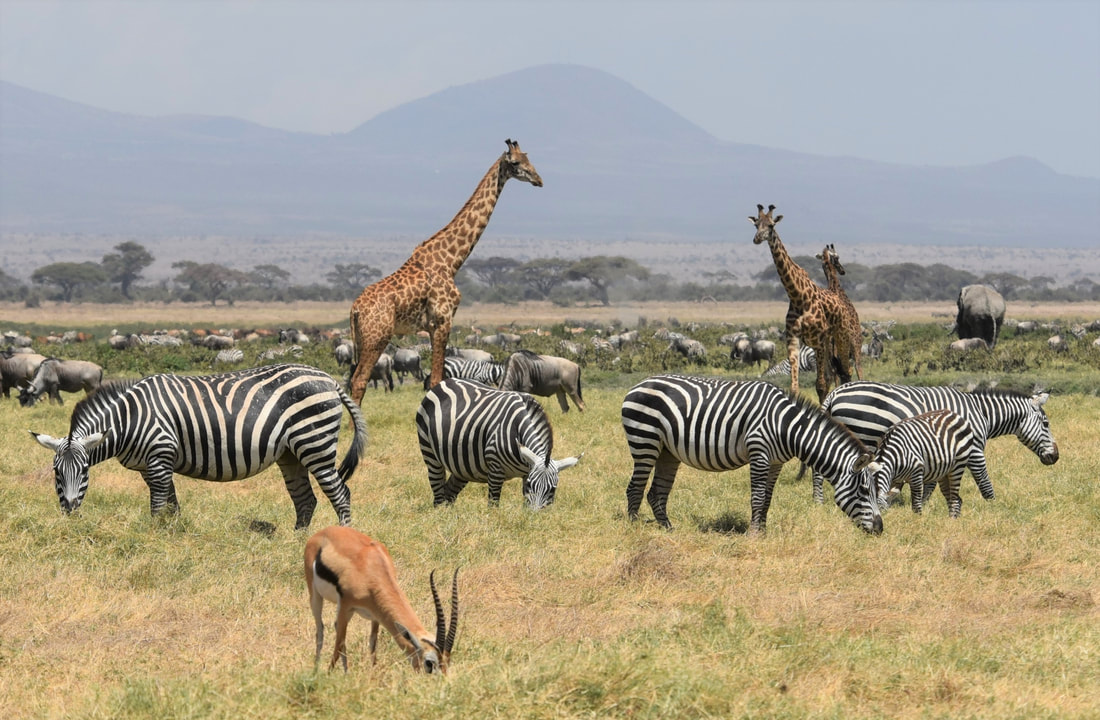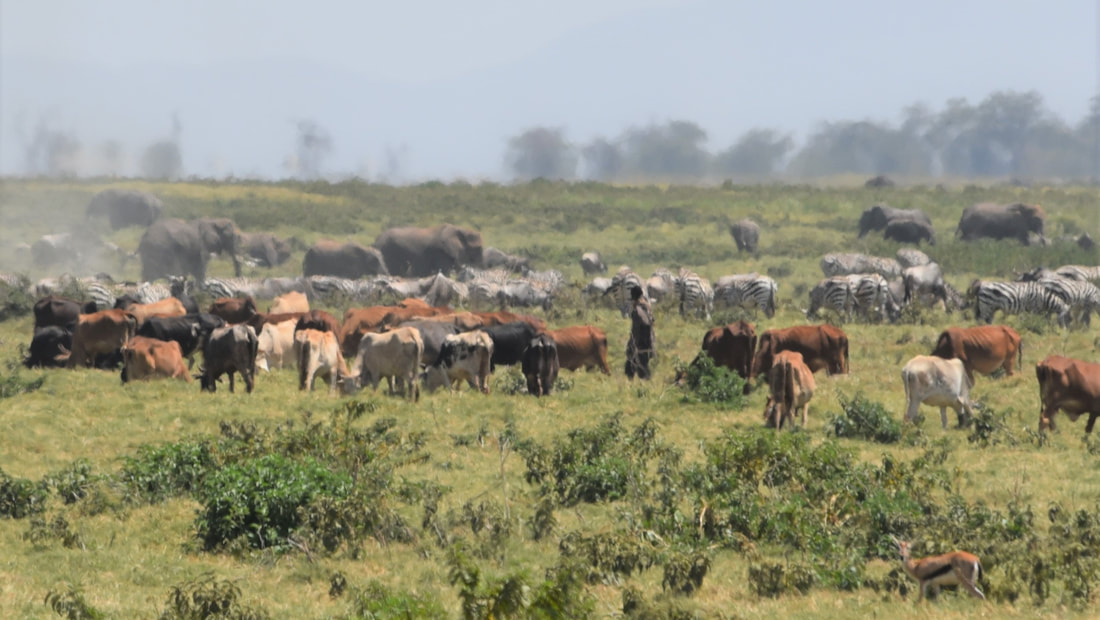 In 1883 explorer Joseph Thomson wondered how such enormous numbers of wildlife could live in Amboseli.
In 1883 explorer Joseph Thomson wondered how such enormous numbers of wildlife could live in Amboseli. Our two most recent papers document the changes in Amboseli ecosystem from the free-ranging movements of subsistence livestock pastoralists and wildlife in the 1960s to a human-dominated landscape of our global age. The longest running ecosystem monitoring program of its kind, the ACP study is momentous in showing humans now far exceed natural forces such as rainfall in defining the numbers and distributions of wildlife and livestock. We give abstracts of the two papers and broad conclusions below with links to the full articles.
The changing role of natural and human agencies shaping the ecology of an African savanna ecosystem
Abstract
Reconstructing the historical interplay of wildlife and pastoralists in the African savannas is clouded in contemporary studies by the transformation of subsistence societies and land use changes. We draw on five decades of monitoring by the Amboseli Conservation Program (ACP) to illustrate the rainfall-plant-herbivore linkages in a free-ranging wildlife-livestock system transitioning to contemporary savanna landscapes. In half a century, the coupled interactions of wildlife and livestock in the Amboseli ecosystem driven by rainfall and water sources have been severed and reshaped by farming, land subdivision, sedentism, poaching and intensified herbivory. Livestock ranges have expanded, wildlife ranges have contracted and overlapping spatial use has fluctuated with population sizes. In contrast, wildlife and livestock herds have been sustained where the rangelands remain open. A decrease in the mean body size reflecting a shift to small stock among pastoralists has increased species dominance, decreased diversity, and elevated biomass turnover and the probability of extreme shortfalls. In recent droughts pastoralists have been importing food supplements to reduce drought risk and purchased livestock to restock herds, further uncoupling the rainfall-herbivore link. Our study reinforces the view that biomes worldwide are shaped at an accelerating pace by human agencies rather than endogenous environmental factors. Disputes over models of rangeland systems echo the wider debate over using natural ecosystems as benchmarks for conservation verses “gardening” nature. We argue that models of natural ecosystems fail to account for the dominant role of humans in contemporary ecosystem yet that it is possible to monitor the complex interplay of human and natural systems and interpret the changes in terms of ecological function using macroecological analysis. The key finding for conservation is the importance of space, landscape heterogeneity, social networks and mobility in sustaining the large herbivore populations.
Download the full paper below.
The photos and captions are taken from We Alone: How Humans Have Conquered the Planet and Can Also Save it, which covers the story of how the long history of coexistence of pastoralists and wildlife in Amboseli holds lessons for sharing our planet in future.
| the_changing_role_of_natural_and_human_agencies__ecosphere_2021.pdf |
David Western, Victor N. Mose, David Maitumo and Caroline Mburu
Abstract
Studies of the African savannas have used national parks to test ecological theories of natural ecosystems, including equilibrium, non-equilibrium, complex adaptive systems, and the role of top-down and bottom-up physical and biotic forces. Most such studies have excluded the impact of pastoralists in shaping grassland ecosystems and, over the last half century, the growing human impact on the world’s rangelands. The mounting human impact calls for selecting indicators and integrated monitoring methods able to track ecosystem changes and the role of natural and human agencies. Our study draws on five decades of monitoring the Amboseli landscape in southern Kenya to document the declining role of natural agencies in shaping plant ecology with rising human impact. We show that plant diversity and productivity have declined, biomass turnover has increased in response to a downsizing of mean plant size, and that ecological resilience has declined with the rising probability of extreme shortfalls in pasture production. The signature of rainfall and physical agencies in driving ecosystem properties have decreased sharply with growing human impact.
Download the full paper below.
| long-term_changes_in_plant_ecology_of_the_savannas.pdf |
The Amboseli study shows the value of using long-term integrated ecological monitoring to track the spatial and temporal changes in the species composition, structure, and function of rangeland ecosystems and the role of natural and human agencies in the process of change.
We compare the Amboseli findings to the long-term studies of Kruger and Serengeti national parks to show that the human influence, whether by design or default, is increasingly shaping the ecology of savanna ecosystems. We look at the findings in the larger perspective of human impact on African grasslands and the world rangelands, in general, and discuss the implications for ecosystem theory and conservation policy and management.
The study was designed and intended to provide ecological information for the conservation of the Amboseli ecosystem. The conservation applications have been detailed elsewhere (Western 1994). More recently the long-term monitoring data formed the basis of the Amboseli Ecosystem Management Plans 2008–2018 and 2020–2030 and the Amboseli National Park Development Plan embedded within the ecosystem plan (KWS 2020) found here.
The Amboseli study reflects universal changes underway. On a global scale, for example, Tucker et al. (2018) found that a wide range of species in the Anthropocene show reduced movements and constricted ranges. The findings demonstrate human impact to be so widespread and pervasive as to call for a reclassification of natural biomes as anthromes (Ellis and Ramankutty 2008). The pervasiveness raises the question of whether ecosystem theories have validity or utility in conservation management, whether baseline reference points are useful given millennial changes (Foster and Aber 2004; Briske et al. 2020), and whether species diversity as a measure of ecosystem functionality is useful. Boles et al. (2019), for example, found in all major ecosystems and climatic zones worldwide that, despite no systematic change in species richness, composition had changed extensively. The biodiversity crisis, they concluded, is more of a case of large-scale reorganization than species loss.
Janzen (1998) and Kareiva et al. (2011) assert that human modification is so great and irreversible as to justify “gardening” nature rather than management based on historical templates. Sinclair and Dobson (2015) argue that protected areas can serve as a control to test whether human-dominated ecosystems are sustainable and robust. Based on the continued growth in protected areas worldwide (McNeely and Miller 1983), and the growing conservation efforts in human-dominated landscapes (Berkes 2007), we consider both protected and non-protected areas to play important and complementary roles (Western et al. 2020). We argue that the worldwide biodiversity loss calls for some level of ecosystem management to prevent land degradation and the erosion of ecological function, services, and resilience as documented in detail in Amboseli. Further, the complexity of ecosystems and the multiplicity of human factors call for monitoring human activity as an integral part of research.
The prospects of conserving wildlife using traditional husbandry and land management practices for sustaining space and winning a place for wildlife among pastoral societies without protected areas have been documented by David Western, Peter Tyrrell, Peadar Brehony, Samantha Russell, Guy Western and John Kamanga Conservation from the inside-out: winning space and a place for wildlife in working landscapes, People and Nature 2020:00:1-13. The success in Amboseli in conserving wildlife by adopting an ecosystem approach and integrating wildlife in pastoral economies on land is documented here.
See publications for full reference list.
Other recent articles you may wish to read include the following:
2020. Álvaro Fernández-Llamazares, David Western, Kathleen A. Galvin, Pamela McElwee, Mar Cabeza. Historical shifts in local attitudes towards wildlife by Maasai pastoralists of the Amboseli Ecosystem (Kenya): insights from three conservation psychology theories. Journal for Nature Conservation 53 125763.
2020. Western, Peter Tyrrell, Peadar Brehony, Samantha Russell, Guy Western and John Kamanga Conservation from the inside-out: winning space and a place for wildlife in working landscapes David. People and Nature 2020:00:1-13.
2020. Scaling up the governance of the commons to sustaining our planet. In A Book of the Body Politic. Connecting Biology, Politics and Social Theory. San Giorgio Dialoge 2017. Latour, B., Schaffer, s and Gagiardi, P. Fondazioni Giorgio Cini. ISBN 9788896445228
2020. We Alone. How Humans Conquered the Planet and Can Also Save It. Yale University Press.
2020. With Potts, R. et al. Key Pleistocene human adaptations emerged during a shift to less predictable resources. Science Advances 6:eabc 8975 1-14.
2020. David Western. A review of Nairobi National Park Plan 2020-2030. Swara. Restoration calls for good science to guide management. Swara July-September 2020.
2021. Kariuki, R.W.; Western, D.; Willcock, S.; Marchant, R. Assessing Interactions between Agriculture, Livestock Grazing and Wildlife Conservation Land Uses: A Historical Example from East Africa. Land 2021, 10(1), 46; https://doi.org/10.3390/land10010046.

 RSS Feed
RSS Feed
